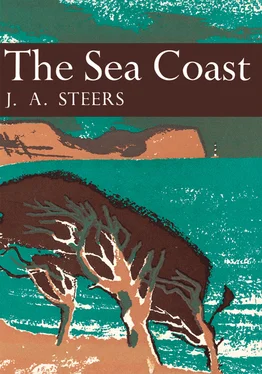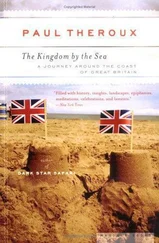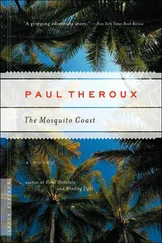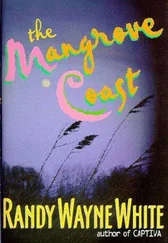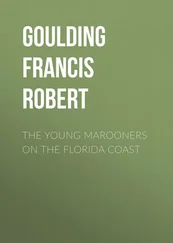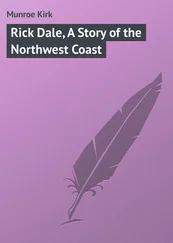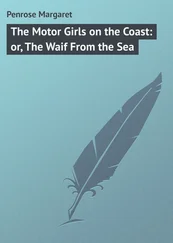Coastal scenery also depends greatly on that of the country to which it forms the margin. The contrast between the flat-topped cliffs of the Hartland district of North Devon and the hog’s-back cliffs of Exmoor; or the striking difference between the even skyline of the cliffs of the Tenby and Gower Peninsulas or of the Lizard district with the coast on either side of Salcombe Harbour in South Devon or with that of the north coast of Sutherland, all demand attention if we are going to explain fully the scenery of our coastline.
I am fully aware of many of the shortcomings of this book, and also of the generalizations made in it. A complete explanation of the intricate landscape of the Western Isles and mainland of Scotland is not at present possible. The origin of the North Sea and its connection with the cliffs of our east coasts, the reason for the Shetland archipelago, the former river systems of the North Channel and Irish Sea, the significance of the Cornubian peninsula, and the means of separation of Britain from the Continent and of Ireland from Britain are all great and largely unsolved problems. Yet to appreciate our coastline fully we must try to understand these topics just as much as the more obvious ones of erosion and accretion. If I have done nothing else than provoke discussion or disagreement I am well satisfied because it has always seemed to me that some of these matters have been all too readily overlooked—and it is a long time since Sir Haiford Mackinder introduced some of them in his Britain and the British Seas.
Once again I acknowledge with great pleasure my indebtedness to Dr. H. Dighton Thomas, who read through this book in typescript and made many helpful suggestions. To the Editors of the New Naturalist volumes I am also grateful for much constructive help and criticism. The diagrams have nearly all been drawn for me by Mr. L. R. Thurston, who spent much time and care on them. The sources of those diagrams based on the work of others are all duly acknowledged elsewhere. Permission to use maps and diagrams which have appeared in official publications has been obtained from the H.M. Stationery Office. The Royal Geographical Society and the Cambridge University Press have also kindly allowed me to make use of certain maps and figures. The photographs are from various sources, and I am indeed glad to record my thanks to those who have allowed me to make use of them. The origin of each photograph is given below it.
In order that the large figures 44, 47 and 50 may be printed from single blocks, they have had to be placed somewhat remotely from the text-passages to which they refer.
The Index was compiled by Mr. Geoffrey Willett, to whom I am most grateful.
J. A. STEERS,
Cambridge, May, 1952
Preface to the Third Edition
An appendix has been added in this edition. It begins with a brief account of the great flood of 1953, and then summarizes some of the important trends in coastal work, mainly since the War.
J. A. STEERS
Cambridge, July, 1960
Preface to the Fourth Edition
In this edition a note has been added to Chapter 9 in order to call attention to recent work on raised beaches.
J. A. STEERS,
Cambridge, May, 1968
It should be noted that throughout this book Plate numbers in arabic figures refer to the Colour Plates, while roman numerals are used for Black-and-White Plates
THE RELATION OF THE COAST TO THE GENERAL STRUCTURE OF GREAT BRITAIN

BEFORE discussing coastal matters sensu stricto, it will repay us to glance at the general relation between the structure of the rocks forming the coastline of Great Britain and that of the country as a whole (see Fig. 1).
Although the interpretation of much of the geology of Scotland is still hypothetical, the main structural regions of the country are clearly differentiated, and are associated with coastlines possessing marked characteristics. The dominant grain of Scotland is north-east and south-west over most of the country, but more nearly north-north-east and south-south-west in the North-west Highlands. To this geological fact must be added the physical one—namely, that Scotland is higher in the west than in the east. The slope of the country to the east and south-east is related to the preservation of the Old Red Sandstone in Caithness and around the Moray Firth. Formerly this formation, as well as still newer ones, spread over some of the mountainous interior.
The effect of the grain on the coastline is apparent in many places, but from Cape Wrath to the Caithness border, along the Moray Firth particularly in Banffshire, in Argyll, Jura, Islay, and Kintyre, it is conspicuous. This is emphasised in Figs. 20 and 21, which illustrate how the headlands and re-entrants of Sutherland and Banff follow the trend of the rocks which form them. In Argyll and the adjacent islands the correspondence is often more obvious, but is best appreciated by a study of a geological map of the whole country.
Whilst the folds and thrusts, which enter so largely into the structure of the North-west Highlands, are generally parallel to the coastline, it is nevertheless the case that the north-west and south-east trends of sea lochs, valleys, and igneous dykes, produce the most effective coastal scenery in western Sutherland and Wester Ross.
The gradual change from the north-west and south-east trend of the sea lochs between Cape Wrath and Skye, through the east and west direction of those between the Kyle of Lochalsh and Loch Sunart, and then to the south-westerly trend of the Great Glen and the Argyll lochs, hardly reflects the major structural traits of the country, which are more clearly shown in the parallelism of the Outer Hebrides and the North-west Highlands, and that of the Coll-Tiree ridge with the prevailing grain of the Grampians. The region from the Shiant islands to the south of Mull was at one time buried under lavas and other products of the great volcanoes of Skye, Rum, Ardnamurchan, and Mull. This and the later collapse of parts of the area obscure the relations between the coastline and the general structure of the country.
In the Central Valley, between the great faults bordering the Highlands and the Southern Uplands, a tract of country, the rocks of which have been folded in a south-west and north-east pattern, has been dropped down. This general direction of strike of the strata as shown on a map is clearest in the Old Red Sandstone outcrop extending from Loch Lomond to Stonehaven, but it is also apparent in the trends of the Ochil and Sidlaw Hills, and in the folds involving the Carboniferous strata. The trend, however, has no very pronounced effects on the coast except perhaps between Stonehaven and Arbroath. In the Firths of Tay and Forth, and also inland, numerous outcrops of igneous rock and the necks of old volcanoes are more likely to focus the attention, than is the influence on scenery of the strike of the beds in which they are intruded.
The marked trend of the Southern Uplands locally affects the coast, especially near St. Abb’s Head and in Wigtownshire. It may also be observed in detail on parts of the Solway coast, 1 and in the line of the Solway Firth. The bays and larger inlets of Wigtown, Kirkcudbright, and Dumfries are discordant, and may recall a time when rivers flowed on a cover of newer rocks and so passed athwart the grain of the older rocks.
The cartographical relation between the major structural trends of the country and the coast is close enough, but the field relationships are often obscured; along many miles of the Moray Firth and of Aberdeenshire sand flats and wide dune systems hide it completely. Elsewhere, the frequent raised beaches and the grassing over of the old cliffs may divert attention from it. Yet in the trend of small inlets, the lines of cliff faces, the direction of certain valleys, and in all sorts of other ways, the grain has a pervasive effect. In places, not only cliff detail but also that of the adjoining land, may be completely hidden by boulder clay. This, however, is a more marked characteristic of coasts south of the Border.
Читать дальше
